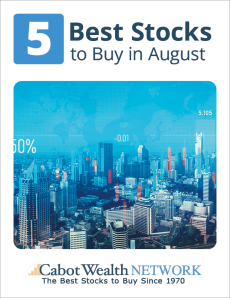By Michael Cintolo, Vice President of Investments, Cabot Wealth Network
Blackstone (BX)
Blackstone is the granddaddy of Bull Market stocks, with its fingers in many different portfolio cookie jars that bring in lots of fee-related income—at the end of June, the firm had assets under management of $1.08 trillion, including $809 million that were fee-related, which has led to solid cash flows (91 cents per share of fee-related earnings in Q2, $3.64 per share during the past 12 months). However, the stock has been lagging likely due to the fact that real estate is still the largest part of business ($336 billion in assets) but performance has been underwhelming (down during the past 12 months), which has kept a wrap on growth (real estate assets up just 1% over the past year while fee-related earnings are down 4% so far in 2024). Growth has also been slow at private equity, another big component of business. Even so, business has been solid overall (the variable dividend totaled $3.39 per share during the past year, which doesn’t hurt), with total assets up 7% from a year ago, and the stock has changed character as Fed rate cuts—and what should be an improved environment for everything, especially real estate—come into view. To be fair, there are some other Bull Market stocks that have acted better since last fall, but Blackstone has the potential to be a vacuum for institutional money if the environment truly turns up. Indeed, the stock was very flat for the first six months of the year, but has come alive in recent weeks, bursting to new highs on solid volume, the start of what we think will be a sustained run.
Coinbase (COIN)
We’ve been keeping an eye on Coinbase for a few months now, thinking the consolidation that began in March will eventually give way to a big upside run—and it’s possible that time is getting close, with crypto prices rallying nicely even in the face of a risk-off move in growth stocks of late. While there are more and more plays out there (from miners to owners to power companies), Coinbase looks to us like the go-to institutional way to play the growth of the crypto economy; trading revenue is still the big draw, and it continues to expand in its field (its derivatives arm just launched futures contracts on a variety of crypto coins), though results can swing wildly—in Q1, transaction revenue totaled $1.08 billion, more than double Q4’s tally (!), though most think Q2 saw a good-sized retrenchment. Long-term, volumes should increase both here and overseas, but we’re just as interested in two other factors. The first is Coinbase’s emphasis on subscription and service revenue, from stablecoins to blockchain rewards/staking to interest income to its Coinbase One offering (better trading tools), which brought in $511 million in revenue in Q1 and, while it can bob and weave a bit, is likely to grow steadily over time. And the second is very basic and something we’ve written about before: After spending endlessly during the boom times of 2021, the top brass has cracked down in a big way; in Q1, non-transaction costs were down a whopping 17% from a year ago while full-time employees are down as well. When you put it together, you can see the potential—earnings catapulted to $4.40 per share in Q1 when the stars aligned, and the bottom line could go even higher during the next sustained crypto run. The stock has been very volatile on a day-to-day basis, but overall has consolidated well since March after a humongous prior advance. Earnings are due August 1, but COIN should move more with perception of crypto than anything else; an upside breakout would be tempting.
D.R. Horton (DHI)
The markets have been wrong before, but at this point, traders are pricing in a 90%-plus chance that the Fed cuts rates in September and that we’ll see at least two rate cuts this year—and that definitely is one reason there’s been a rush of buying in homebuilding stocks, with hopes that demand will pick up as money becomes looser and mortgage rates fade. Plus, of course, there’s also the fact that business has been strong despite higher rates, with big margins, earnings and cash flow as housing prices have refused to dip. D.R. Horton is the granddaddy of the group, and it just reported another better-than-expected quarter: Sales inched up 2% from already elevated levels while earnings per share of $4.10 not only rose 5% but topped expectations by 35 cents while pre-tax margins came in at nearly 17%. The growth figures aren’t eye-openers, but perspective here is important—after seeing earnings lift from $4.29 per share in 2019 to $16.52 in 2022, the downphase has seen earnings “only” slip to just south of $14 last year … and now, with the Fed likely to ease, expectations are the bottom line can grow from here, with analysts expecting earnings to rise to nearly $16 next year, which is likely conservative. Helping the cause is a consistent share buyback program, with the share count down 3.4% in the latest quarter vs. a year ago, and the board just reloaded the program with another $4 billion. It’s not an unknown story, obviously, but Horton looks like an institutional way to play a pickup in building activity if the long-awaited Fed move from foe to friend occurs later this year. As for the stock, it actually topped in December and ground sideways and then lower into early July, even dipping below some long-term moving averages … but now it’s come alive, bursting to new highs as big investors see a pickup in activity going ahead.
Lantheus (LNTH)
The federal government is proposing raising the reimbursement rate for specialty diagnostic radio-pharmaceuticals – agents that help identify disease in medical scans. While the final decision won’t come until later this year (could take effect next January), it promises to be a huge boost to Lantheus. The rule would increase the amount paid for Lantheus’ Pylarify, a diagnostic agent used in PET and CT scans of prostates, as well Pylarify AI, which is an AI-based analysis and reporting of those scans; research shows that doctors assisted by AI that have been trained on thousands of x-rays do a better job of identifying cancerous growths. The system is used in every academic hospital in the U.S. and is accessible to 90% of patients who have insurance coverage for it. Pylarify just hit the market a couple of years ago but it’s been a hit, accounting for $259 million in revenue in Q1, up one-third from last year. The new reimbursement proposal probably turbocharges the revenue it can make by nearly doubling the top price paid under specific circumstances. Before this, Wall Street started having concerns Pylarify would see market share shrink due to a current billing cap and the emergence of a competitor, Blue Earth, priced closer to that cap. Even though Blue Earth’s results are inferior to Lantheus’, the expectation was that a segment of clinicians would move toward the less good, but fully paid, option. Still, even before the Medicaid/Medicare fee proposal, Lantheus was expecting 2024 to reflect strong momentum, projecting sales up 17% for the full year to about $1.5 billion, with earnings around $7 per share. The longer-term outlook no doubt improves with the pricing revamp. Lantheus also dominates in an ultrasound enhancing agent for echocardiograms, called Definity. It generated $77 million in revenue last quarter, up 11% year over year, but the big draw is Pylarify. LNTH fell about 50% from mid-2023 to early 2024 on fears of slowing growth, but after rebounding somewhat into April, the stock tightened up for a couple of months—and now has seen overwhelming buying following news of the likely payment change. The path of least resistance has turned back up.
Viking Holdings (VIK)
Leading cruise liners such as Royal Caribbean have had great runs as the initial post-pandemic cabin fever and travel boom has had legs, driving sales and earnings higher, and bookings remain strong looking into next year. Viking Holdings looks like a potential follow-on play to that: It’s a leader in the sector with just over 90 vessels on the water, albeit with a focus on luxury river cruises (80 owned and on the water) with just a couple hundred passengers, no gambling and usually no kids, as well as a general focus on cultural vacations (especially as these cruises often dock at major cities in Europe). That focus, as well as far less competition than ocean cruises, leads customers to book well in advance (11 months on average), which promotes more stable pricing and better gains in revenue per passenger than most peers. The firm is also diving more heavily into ocean cruises (9 ships as of now), and altogether, business is good (revenues up 14% in Q1, occupancy was over 92% for both river and cruise voyages) and the future looks bright, with 91% of 2024 and 39% of 2025 capacity already booked as of mid-May. Indeed, ocean and river bookings for next year are running 30% and 19% (respectively) above their levels from the past year! Combine all of this with some expansion (5% this year, 12% in 2025) and the future should be bright. VIK just came public in May and has been steadily advancing since then, and gaining liquidity, too (market cap of around $16 billion). The uptrend looks solid, though as always, dips toward moving averages would provide better entry points. Earnings are likely out near the end of August.
_____________________________________________________________
To find out more about stocks mentioned in this report or to get names of additional momentum stocks, check out Cabot Top Ten Trader.
The advisory is your ticket to fast profits in stocks that are under accumulation now. Every Monday, Chief Analyst Michael Cintolo will send you his 10 Top Trades for the current market, including detailed fundamental analysis, technical analysis and buy ranges for each stock. Plus... every Friday, you’ll receive his “Movers & Shakers” updates, so you’ll always know his latest thoughts on these fast-moving stocks. Cabot Top Ten Trader is your best source of advice on investing in the market’s hottest stocks.
_____________________________________________________________
About Cabot Wealth Network
This report is published by Cabot Wealth Network which was founded in 1970 by Carlton Lutts, a disciplined investor with an engineering mind who developed a proprietary stock picking system using technical and fundamental analyses.
Since then Cabot Wealth Network, headquartered in Salem, Massachusetts, has grown to become one of the largest and most-trusted independent investment advisory publishers in the country, serving hundreds of thousands of investors across North America and around the world.
[author_ad]


